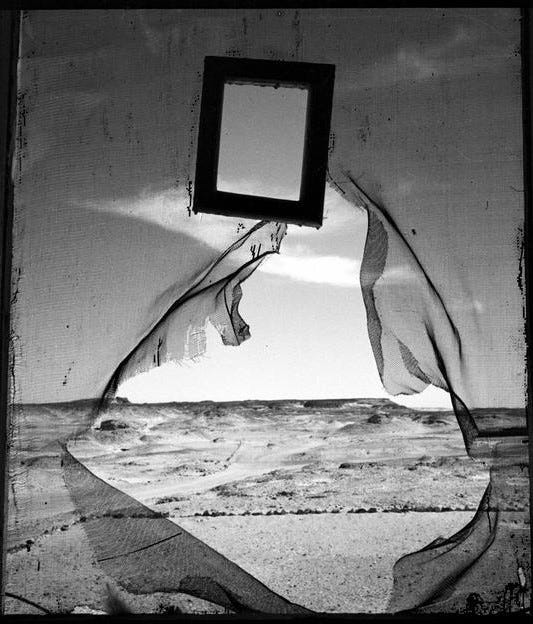When you read the words 'I am a camera' it often means that a person or a narrator in a book is recording visual information dispassionately and taking everything in without selecting or imposing ideas on it. Well, in this imaginary encounter, the voice speaking really is a camera and it has plenty to say about what it sees.
The camera belongs to Lee Miller and the photograph is Portrait of Space from 1937.
This picture seems to be all about experiencing space from inside a body or from within a perceiving machine. I think Lee Miller wanted to try and show the unsettling and believable lies that a camera, or indeed an eye, can tell.
I’d like to acknowledge Katharine Conley, whose article in Angels of Anarchy helped me to write this piece.
I hope you like it!
I am Lee Miller's camera from the 1930s speaking to you now in a whole new century with different world problems. Still, the old uncertainties about truth and perception remain. For instance, where does a human's inside end and the outside world begin? Is there even an 'outside world' at all, apart from countless individual human perceptions? Well, that's a philosophical question going right back to the start of human thought and I am just a camera made of steel, so you can hardly expect me to solve that mystery, can you?
What I can do is change the way you see. Because I am a camera, and I lie.
You are looking at this photograph that I have made and you are enjoying the view of a beach with small waves coming in as you sit inside a tent. You look through the torn netting to a wide horizon out to sea. Just above the tear in the tent material hangs a mirror about the right size for a man to use for shaving or for a woman to comb her hair.
None of this is real.
I, the camera, was positioned by my owner at a window and this is the desert, not the seaside. The mirror is an empty frame. Now you are feeling uncomfortable. To look at the outside from inside a house is a different sensation to being inside the flimsy walls of a tent. And how can sand so suddenly reassert itself when before there seemed to be the beginning of seawater? But now you notice that the far horizon is not level enough to be the sea and wonder how you could have mistaken that sand dune in the far distance as a clifftop near the sea. And why did you assume that the empty picture frame was a mirror?
I am playing with you.
I am a camera. I have no eyes, and yet I can collect visual information. This information is sometimes faulty or ambiguous. What you see here is doubled: desert and beach; home and temporary shelter; picture frame and mirror. But you want to trust me. In fact, you have to trust me, just as you trust your own eyes. Doesn’t the shape of that rip in the netting suggest an eye? You have been occupying my position as I take this photograph as if looking out of your own eyes. But you are not here. You cannot see yourself in this mirror, after all.
All your life you have clung to believing your eyes which relay the information of what is outside, but I am a camera and I can lie without any conscious intention or motive. By that token, why would those eyes you rely upon so completely, so naively, be any different? They are simply machines to collect visual information. Why would they not lie also?
Just before I go, I want to tell you about a short piece I have posted on The Fur Cup’s Homepage.
It’s all about why I think the women surrealists are important, exciting and inspiring and I really hope you’ll visit the page and read it. I explain a little about surrealism, how women featured in the movement and how their contribution has been lost over time but is now being rediscovered. Did you know that this October marks 100 years since the Surrealist Manifesto? I want to make sure the women of surrealism are remembered as well as the men.
Here’s a link to my short article about the women surrealists:
Look out for the next imaginary encounter with a work of surrealist art. These will keep arriving on Tuesdays, roughly twice a month. I do hope you are enjoying them and I’d love it if you dropped by at The Fur Cup on Substack and joined in the comments and discussions there.
Thank you so much for subscribing! It’s free to subscribe but if you’d like to help, please share these emails with people who might also enjoy them to increase my circulation.







"You have been occupying my position as I take this photograph as if looking out of your own eyes. But you are not here." Almost chilling!
But I too love to think and write about what it means to see, what we've actually seen and what we think we've seen. Love this evocative reminder!
I just love your writing! Seriously good